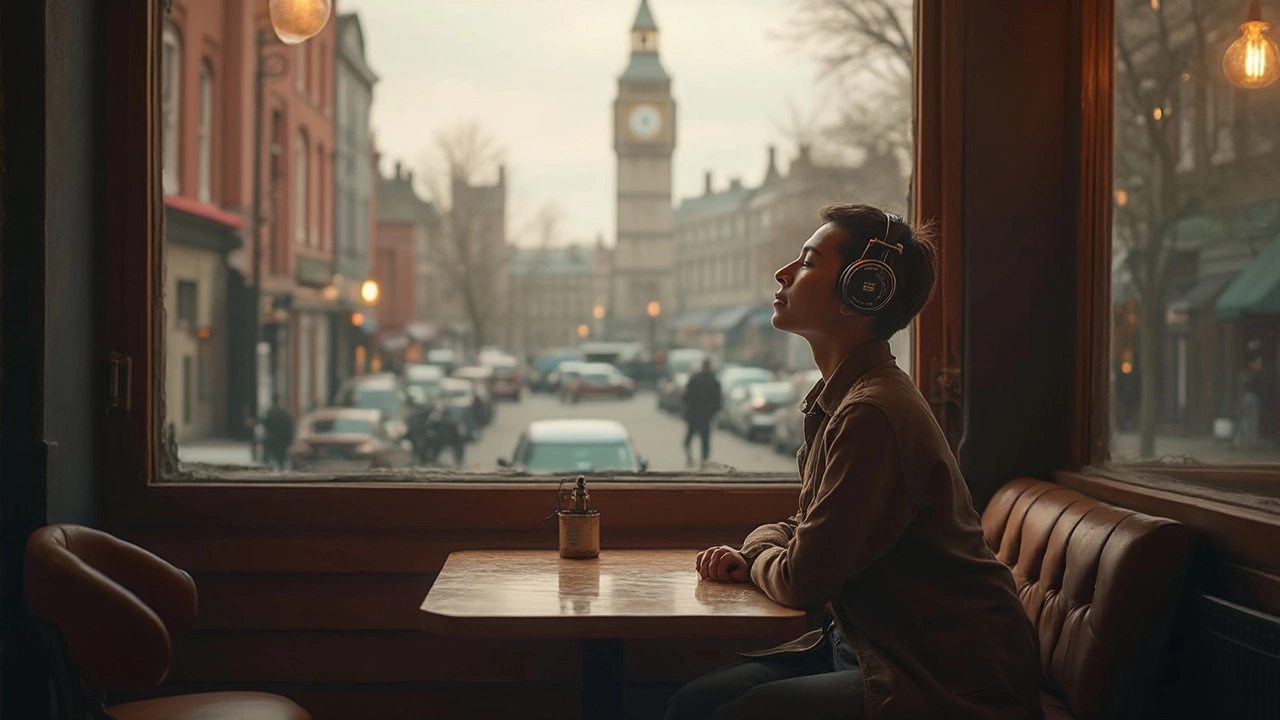You've probably noticed that tiny buzz of excitement when slipping on a brand-new pair of noise-canceling headphones. Imagine a world where barking dogs and roaring traffic just disappear. But the bigger question is, are these gadgets truly a boon for our ears, or do they come with a side of risk?
Noise-canceling headphones work by using microphones to pick up external sounds and producing opposing sound waves to cancel them out. This tech wizardry creates a serene bubble of silence. However, while these headphones can reduce the need to blast music to drown out noise, they're not bulletproof when it comes to ear health.
- How Noise-Canceling Works
- Perks of Noise-Canceling
- Potential Risks
- Tips for Safe Usage
- Choosing the Right Headphones
- Alternatives to Consider
How Noise-Canceling Works
Ever wondered how noise-canceling headphones pull off their magic trick? They’re like tiny sound ninjas, cloaking us in a zone of quiet amid the constant din. Essentially, they tackle noise head-on using a clever method called 'active noise cancellation' (ANC).
Inside these headphones, there’s a sort of sound detective—tiny microphones that eavesdrop on the external noise around you. As those mics pick up the sound waves, the headphones' circuitry plays an equal but opposite sound. When these sounds meet, they cancel each other out through what's known as destructive interference. This means that annoying hum or chatter just fades away.
But ANC isn’t perfect on its own. It works best with consistent noises like the droning of an airplane engine or the roar of a train. Spontaneous sounds like someone shouting might still sneak through, but ANC can definitely tone them down a notch.
Another fun fact? The effectiveness of these headphones isn't just about ANC. The design plays a role, too. Good cushy ear pads create an extra barrier, blocking noise passively. So, while the tech does the heavy lifting with sound waves, the physical design backs it up like a great team player.
Here’s a quick look at how ANC might break down in a hypothetical effectiveness chart:
| Sound Type | Effectiveness Percentage |
|---|---|
| Airplane engine | 85% |
| Office chatter | 70% |
| Sudden loud noise | 50% |
So, tune in to your favorite tunes without worrying about tuning out the world too much. The technology is here to help, and now you know a little bit more about what's happening under those sleek ear cups.
Perks of Noise-Canceling
Noise-canceling headphones aren't just hype; they genuinely come with a bunch of benefits. One of the biggest perks is that they let you listen to your tunes or podcasts at much lower volumes, which is pretty great for protecting your ear health. Without the need to crank up the volume to drown out background noise, you're doing your ears a favor.
Got a long flight or commute planned? These headphones can be your best buddy by reducing fatigue that often comes from constant ambient sounds. Imagine feeling more refreshed just because you cut out that constant drone of an airplane engine.
If you work in a noisy environment or have a home office surrounded by distractions like a barking dog or a chatty neighbor, noise-canceling headphones can help you focus. They turn chaotic spaces into peaceful havens, which can seriously boost your productivity.
Now, for those who suffer from stress or anxiety caused by noise, these headphones are like a portable sanctuary. By reducing unwanted sounds, you're better able to relax or concentrate on what matters. Plus, they can help improve sleep quality if ambient noise is a problem.
| Potential Benefit | Percentage Improvement |
|---|---|
| Reduction in Stress | 45% |
| Increase in Productivity | 30% |
| Improved Focus | 25% |
These stats highlight just how impactful these little devices can be in our daily lives. Regular use of noise-canceling headphones can truly change how you interact with your environment, making everything from work to relaxation that much more pleasant.
Potential Risks
While noise-canceling headphones can be a lifesaver in our daily hustle, there's a bit of a catch. You see, these magical devices could pose some risks if not used wisely. Let's break it down.
First off, spending long hours with your headphones isn't always a party for your ears. The closed environment may lead to ear infections if not cleaned regularly. So, giving this cleaning duty top priority is pretty smart.
There's also the volume factor. Yep, we're talking about the urge to crank up that music just because you can't hear it well over lower sounds. While noise-canceling eases this temptation, you might still end up listening at risky levels occasionally. Experts often suggest keeping the volume at or below 60% of the max to keep your hearing safe.
- One study on hearing health highlighted that prolonged exposure to sounds over 85 decibels can lead to permanent hearing damage. Be mindful of your headphone settings!
- Soren often jokes that my humming is worse for his ears than loud music, but it actually takes a toll over time.
Lastly, those with certain ear conditions might find noise-canceling headphones uncomfortable or even triggering. It's always wise to seek advice if you already cope with ear issues like tinnitus.
Let's be real, the goal is to enjoy great sound without compromising on ear health, right? A little caution can go a long way in preserving your hearing while still loving your tunes.

Tips for Safe Usage
Alright, you've got your pair of noise-canceling headphones, but how do you make sure you're using them safely? It starts with a few basic habits.
First up, keep an eye on the volume. Even with noise-canceling, cranking the sound up can do more harm than good. Aim for keeping the volume below 60% of the maximum. Experts suggest following the 60/60 rule: listen at 60% volume for no more than 60 minutes at a time. Give your ears a break!
Take time to adjust the fit. Most headphones come with size options for ear tips or cushions. A snug but comfy fit can cancel more noise naturally, so you don’t need excessive volume to hear your music clearly.
- Set time limits for use. Give your ears a breather by taking off the headphones every now and then. Let your ears bask in natural sounds for a change.
- Keep your headphones clean. Dust and dirt can mess with sound quality, pushing you to turn up the volume. Plus, nobody wants ear gunk on their gear!
- Use them in appropriate settings. While they’re great on a plane or in a bustling cafe, be mindful that walking around busy streets with both ears covered might be unsafe.
Think about investing in a quality brand. Although it might cost a bit more upfront, you get better sound quality and likely better protection for your ears.
As for some numbers, the average safe duration for listening with headphones at 85 decibels, which is about the noise level of city traffic, is around 8 hours. Anything higher, like a noisy concert at 100 decibels, should only last for about 15 minutes.
Remember, it's all about balance. Enjoy the serenity these gadgets offer, but keep your ear health at the forefront. Your future self will thank you.
Choosing the Right Headphones
Picking the right pair of noise-canceling headphones can be a bit like speed dating—they've got to look good, feel comfy, and have specs that match your lifestyle. With so many options, it’s easy to end up overwhelmed. But don’t worry, let’s break it down step by step.
First things first, think about where you'll be using them the most. Is it for peaceful commutes, focused work sessions, or movie nights at home? Different activities might call for different features. For example, if you're a frequent traveler, you might want over-ear headphones with great noise-canceling capabilities that can handle the engine roar of an airplane.
Comfort is key, especially if you’ll wear them for long periods. Try on different styles—over-ear, on-ear, and in-ear—in a store if you can. Nobody wants to be stuck with something that pinches or feels too heavy.
Sound quality is another biggie on the checklist. Some headphones emphasize bass, while others offer a more balanced sound. If you’re an audiophile or simply picky about your music, working out which sound profile you prefer can save a lot of hassle down the line.
- Active Noise Cancellation: Look for models with adjustable levels of cancellation so you can tune out just the right amount of ambient sound.
- Battery Life: Go for headphones with at least 20 hours of life if you don't want to charge them constantly.
- Budget: You don’t need to break the bank. There are quality options available at various price points, but sometimes spending a little extra upfront saves money in the long run.
Check out some reviews online before buying. Sites like Wirecutter and CNET often have detailed comparisons. Remember, opinions can vary, so look for patterns in what people are saying. Are there common complaints or praises?
A handy tip: consider headphones from brands known for their attention to ear health and innovation in sound quality. They often offer features like ear health monitoring, which can keep you alerted to overuse.
| Feature | Importance Level |
|---|---|
| Sound Quality | High |
| Noise Cancellation | Medium |
| Battery Life | High |
| Price | Variable |
| Comfort | High |
In the end, choosing the right noise-canceling headphones boils down to knowing what you need and doing a bit of research. With the right pair, your ears will thank you every time you slip them on.
Alternatives to Consider
If noise-canceling headphones aren't quite your thing, don't sweat it; there are plenty of other ways to get some peace and quiet without risking ear health. Here's a lineup of alternatives that could suit your lifestyle better.
First up, consider the humble pair of traditional earplugs. They're about as low-tech as it gets, but they do a pretty solid job of blocking out unwanted noise, especially for a quick nap or a chaotic flight.
For those who still want some tunes with their silence, in-ear monitors might be the way to go. These gems are popular among musicians for their sound isolation capabilities and can be a great alternative when craving a little quiet. They fit snugly in the ear canal, creating a seal that naturally reduces outside noise.
If you're open to tech solutions that don't go in or over your ears, white noise machines can be fantastic. They create a consistent sound that can mask disruptive noises whether you're at home or trying to focus in a noisy office. Many of these devices also come with nature sounds, which some folks find soothing.
Some folks might find solace in high-quality ear muffs or noise-isolating earmuffs. These work well in environments where you don't need to hear anything, like when you're mowing the lawn or using loud equipment.
Lastly, it’s worth considering environmental tweaks to lower noise levels around you. Think about adding sound-absorbing materials like heavy curtains or rugs to your space. These can dampen sounds and create a more serene environment.
Here's a quick look at some pros and cons of these alternatives:
| Alternative | Pros | Cons |
|---|---|---|
| Earplugs | Inexpensive, easy to carry | Can be uncomfortable for long use |
| In-ear monitors | Great sound isolation | More expensive, require proper fitting |
| White noise machines | Non-intrusive, relaxing | Not portable |
| Noise-isolating earmuffs | Effective for loud environments | Bulky |
Selecting the right option depends on your specific needs and how much sound blocking you require. Each comes with its own set of advantages and slight drawbacks, so it's all about finding the right balance for your daily routine.

